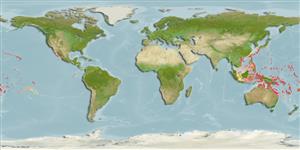Common names from other countries
Classification / Names / Names
Namen | Synonyme | Catalog of Fishes (gen., sp.) | ITIS | CoL | WoRMS
Environment: milieu / climate zone / depth range / distribution range
Ökologie
Riff-verbunden; tiefenbereich 0 - 25 m (Ref. 122), usually 5 - 15 m (Ref. 104244). Tropical
Pacific Ocean.
Length at first maturity / Size / Gewicht / Alter
Maturity: Lm ? range ? - ? cm Max length : 40.0 cm TL Männchen/unbestimmt; (Ref. 122); common length : 30.0 cm TL Männchen/unbestimmt; (Ref. 122); max. veröff. Gewicht: 500.00 g (Ref. 122); max. veröff. Alter: 6 Jahre (Ref. 104241)
Body-wall thickness: 0.6 cm (Ref. 122). Color: blackish-brown (appearing black at depth) over entire body, dorsal surface textured, anus terminal, papillae sparse and short, anal teeth nodulous or serrated (Ref. 104244).
A poorly known species. Collected by divers for artisanal fisheries, but not intensively so, as it is found in lower densities and has a deeper distribution than other "blackfish" species. Processed product is not distinguished from those of other Actinopyga species; moderate commercial value. Occurs in moderately shallow water; never found on reef flats, but on flagstones of reef slopes (Ref. 122), particularly on sand on fore reef slopes (Ref. 85218). On coarse sand with coral rubble. Also found on semi-sheltered bay reefs with boulders and coral rubble; seldom on lagoon reefs or inshore reefs (Ref. 92930). Populations reach medium densities up to 0.1 per square meter. A poorly known species (Ref. 122).
Conand, C. 1998. (Ref. 122)
IUCN Rote Liste Status (Ref. 130435)
CITES Status (Ref. 108899)
Not Evaluated
Not Evaluated
Bedrohung für Menschen
Harmless
Nutzung durch Menschen
Fischereien: kommerziell
| FishSource |
Tools
Internet Quellen
Estimates based on models
Preferred temperature
(Ref.
115969): 24.6 - 29.3, mean 28.3 (based on 1648 cells).
Verwundbarkeit
Low to moderate vulnerability (30 of 100).
Preiskategorie
Unknown.
